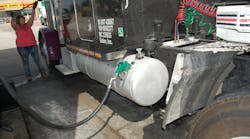Recent analysis released by the Energy Information Administration (EIA) forecasts a continued decline in diesel and gasoline prices for the rest of 2014, primarily due to declines in global crude oil prices.
After reaching a summer peak of $3.70 per gallon in late June, U.S. average regular gasoline retail prices fell to $3.45 per gallon by the end of August, the agency said – the lowest price on the Monday before Labor Day since 2010.
EIA expects that U.S. regular gasoline retail prices will continue to fall through the end of the year, reaching a projected $3.18 per gallon in December, which would mark the lowest monthly average since January 2011.
Diesel fuel prices, which averaged $3.92 per gallon in 2013, are now expected to fall to an average of $3.86 per gallon by the end of this year and $3.82 per gallon in 2015, according to EIA’s current Short Term Energy Outlook (STEO) – prices 2 cents and 5 cents lower than the agency’s previous diesel projections.
This week, the national average retail pump price for diesel is down 1.3 cents to $3.801 per gallon; which is 17. 3 cents cheaper per gallon compared to the same week in 2013, EIA reported.
Diesel prices declined in every region of the country this week, exceeding the $4 per gallon mark in only two areas: California, down 1.7 cents to $4.062, and the West Coast, down 1.5 cents to $4.019. Note that with California removed from the mix, average West Coast diesel prices declined 1.2 cents to $3.967 per gallon.
The Central Atlantic and New England regions posted the biggest one-week drop in diesel prices, EIA said: a 2.3 cent decline to $3.903 per gallon and a 2.2 cent decline to $3.911 per gallon, respectively.
The national average retail pump price for gasoline also dropped this week, falling 4.9 cents to $3.408 per gallon, which is 13.9cents per gallon cheaper compared to the same week in 2013, EIA noted.
Gasoline prices fell in all regions of the country, declining the most in the Midwest and along the Gulf Coast: falling 8.1 cents to $3.357 and 5 cents to $3.173 (which is also the lowest price for gasoline in the U.S. this week) respectively.
EIA added that, though the West Coast registered a 4 cent decline in gasoline prices to $3.663 per gallon, that’s actually 2.3 cents per gallon higher when compared to the same week in 2013.
The agency also noted in its latest STEO that motor fuels consumption is on the rise again in the U.S. EIA revised total U.S. petroleum and other liquids consumption for 2013 upwards by 74,000 barrels of oil per day (bbl/d) to 18.96 million bbl/d, included an upward revision in gasoline consumption of 69,000 bbl/d.
Total U.S. petroleum and other liquids consumption rose by 470,000 bbl/d in 2013, the agency noted – a 2.5% jump that represents that the largest annual increase since 2004, with motor gasoline consumption increasing some 1.9% or 160,000 bbl/d alone.
For this year, EIA expects total liquid fuels consumption to fall slightly by 0.2% in 2014, with a year-over-year increase in total consumption of 170,000 bbl/d during the first quarter of 2014 expected to be more than offset by an average 150,000 bbl/d decline during the second half of the year.
Distillate fuel consumption – which includes diesel – is projected to increase by an average of 160,000 bbl/d or 4.2% by the end of 2014, the agency said.



